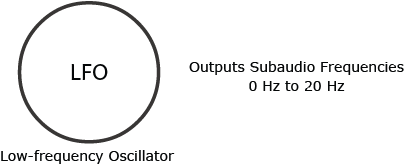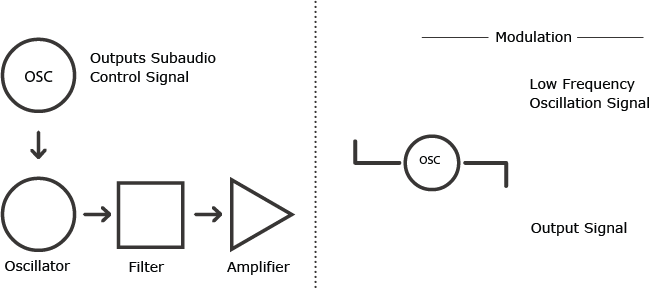31. Low-frequency Oscillators
A low-frequency oscillator, often known as an LFO, is another time-variant controller that, like the envelope generator, can induce change in an oscillator, filter, or amplifier, depending on which module is the destination of an LFO control signal. This time-variant controller outputs frequencies in the subaudio range. Like the oscillator in the generator category, it also outputs periodic waveforms at specifiable frequencies. Since the frequency of the LFO is in the subaudio range, a listener will not hear the output directly, but rather will hear the results of the LFO on the output.

Diagram 31-1: A low-frequency oscillator.
From a musical standpoint, the fundamental difference between the output of an envelope generator and the output of a low-frequency oscillator is simple. The envelope generator outputs a shape that is non-periodic, while the low-frequency oscillator outputs a shape that is periodic. This difference makes the envelope generator useful in controlling the shape of the amplitude from the beginning of a sound to its end, and the low-frequency oscillator best used for creating vibrato or tremolo results. This is a good example of the dictum: Different tasks, different tools.
User-definable parameters vary somewhat from system to system but usually three parameters can be set, the first being the waveform, usually selectable from a group of standard waves such as the sine, triangle, square, and sawtooth; the second being the frequency of the waveform; while the third available setting determines the amount of change.
Thus you might begin with a triangle wave, set at 1 Hz, modulating the frequency of the oscillator. If you changed the LFO frequency to 6 Hz and reduced the modulation, the result would be a vibrato effect.




Example 31-2: The LFO outputs a periodic shape that can be adjusted and applied to an oscillator, to modify a signal.
Using the same settings, if you sent this controlling LFO signal to the amplifier you would accomplish a tremolo effect.




Example 31-3: The LFO outputs a periodic shape that can be adjusted and sent to an amplifier to modify a signal
Now if you change the LFO again so that you select a triangle wave with a frequency of some 3 Hz under high modulation, and send its output to control the filter, you would produce a "wah-wah" effect.




Example 31-4: The LFO outputs a periodic shape that can be adjusted and sent to a filter to modify a signal.
Such selections demonstrate only a small number of the many possible ways a musician can employ a low-frequency oscillator. In conjunction with the envelope generator, the LFO opens an exciting and vast new potential for inducing expressive changes in music.



